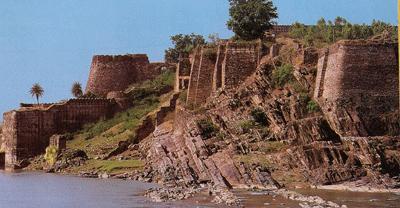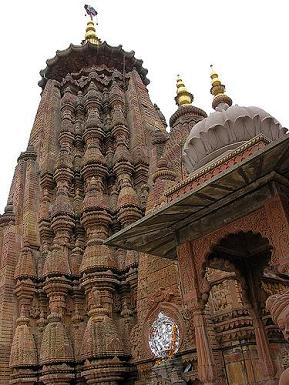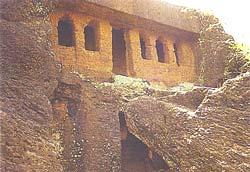
History of jhalawar The chief town of jhalawar, also known as Patan or Jhalrapatan (pop.7955 in 1901), was founded by Zalim Singh in 1796, by the side of an artificial lake. It was the centre of trade for the eponymous princely state, the chief exports of the which were opium, oil-seeds and cotton. The palace is four miles north of the town. An extensive ruin near the town is the site of the ancient city of Chandrawati, said to have been destroyed in the time of Aurangzeb. The finest feature of its remains is the temple of Sitaleswar Mahadeva (c. 600). The former ruling family of jhalawar belonged to the Jhala clan of Rajputs, and their ancestors were petty chiefs of Halwad in the district of jhalawar, in Kathiawar. About 1709 one of the younger sons of the head of the clan left his country with his son to try his fortunes at Delhi. At Kota he left his son Madhu Singh, who soon became a favorite with the maharaja, and received from him an important post, which became hereditary. On the death of one of the Kota rajas (1771), the country was left to the charge of Zalim Singh, a descendant of Madhu Singh. From that time Zalim Singh was the real ruler of Kota. He brought it to a wonderful state of prosperity, and under his administration, which lasted over forty-five years, the Kota territory was respected by all parties. In 1838 it was resolved, with the consent of the chief of Kota, to dismember the state, and to create the new principality of jhalawar as a separate provision for the descendants of Zalim Singh. The districts then severed from Kotah were considered to represent one-third (120,000) of the income of Kotah; by treaty they acknowledged the supremacy of the British, and agreed to pay an annual tribute of Rs.8000. Madan Singh received the title of maharaja rana, and was placed on the same footing as the other chiefs in Rajputana. He died in 1845. An adopted son of his successor took the name of Zalim Singh in 1875 on becoming chief of jhalawar. He was a minor and was not invested with governing powers till 1884. Owing to his maladministration, his relations with the British government became strained, and he was finally deposed in 1896, "on account of persistent misgovernment and proved unfitness for the powers of a ruling chief." He went to live at Varanasi, on a pension of Rs.2,000 and the administration was placed in the hands of the British resident. After much consideration, the British resolved in 1897 to break up the state, restoring the greater part to Kota, but forming the two districts of Shahabad and the Chaumahla into a new state of area 810 square miles, which came into existence in 1899, and of which Kunwar Bhawani Singh, a descendant of the original Zalim Singh, was appointed chief. The population of the state was 90,175 in 1901, with an estimated revenue of Rs.26,000 and a tribute of Rs.2000. The city of jhalawar was founded by Jhala Zalim Singh (First), who was the then Dewan of Kota state (1791 A.D.). He established this township, then known as Chaoni Umedpura, as a cantonment. The township was surrounded with dense green forests and wild animals. Jhala Zalim Singh often came here for hunting and he liked the place so much that he wanted to develop it as a township. The objective to develop this place as a military cantonment was due to the fact that Maratha invaders passed through this central place from Malwa towards Kota to capture Hadoti states.  Founder of jhalawar, Jhala Zalim Singh Legendary Jhala Zalim Singh recognized the importance of this place and started to develop it as a military cantonment and township, so that he could use this place to attack and stop Maratha invaders before they can reach to Kota state. Chaoni Umedpura got developed as a cantonment and township around 1803-04 A.D. Colonel Todd, who visited the region in December, 1821 described this area as the cantonment established by Jhala Zalim Singh plus a well-established township with large houses, havelis, and surrounding walls. In 1838 A.D., English rulers seperated jhalawar state from Kota state and gave it to Jhala Madan Singh, the grandson of Jhala Zalim Singh. He developed his administration services to develop the state of jhalawar. He resided in Jhalara Patan for a long time and started to build The Garh Palace (1840 - 1845 A.D.). He was the first ruler of jhalawar state and made his great contribution in the history of jhalawar. Jhala Madan Singh ruled jhalawar from 1838 to 1845. After his death, Jhala Prithvi Singh became the ruler of jhalawar, and ruled for around 30 years. Rana Bhawani Singh Ji, who ruled jhalawar state from 1899 to 1929 A.D., did remarkable work in the development of jhalawar state. His active involvement was in the fields of social activities, public works (construction), education, administration, etc. During his time, a number of genius personalities of jhalawar gave their active hand in these activities. Successors for Maharana of jhalawar State. Sh. Madan Singh, Maharaj Rana of jhalawar (1838-1845) Sh. Pirthi Singh, Maharaj Rana of jhalawar (1845-1875) Sh. Bakht or Zalim Singh, Maharaj Rana of jhalawar (1875-1897) Sh. Bhawani Singh, Maharaj Rana of jhalawar (1897-1929) Sh. Rajendra Singh, Maharaj Rana of jhalawar (1929-1943) Sh. Harish Chandra ,Maharaj Rana of jhalawar (1943-till merger of jhalawar State in Rajasthan.) Zalim Singh The Great Administrative Zalim Singh was known for his administrative deeds as well as for turning barren lands into fertile ones, and he adopted the same principle for jhalawar. But this time it was not scented flowers and trees that he planted but opium, which turned in a hefty revenue through local sale and export to distant China. Even today jhalawar is one of the main opium producing centres in India, and during the opium harvest sprawling fields with miles of yellow poppy are a common sight.  jhalawar Turned As A Commercial Mart With the setting up of a well-planned town, Zalim Singh ensured that the wealthiest of merchants settled in jhalawar. With his understanding of the administrative system, he introduced the municipality system in jhalawar and had a stone pillar inscribed with the basic laws and regulations of the town. These laws were to assure the affluent traders of the security of their homes and wealth. Anyone flouting these judicatures was dealt with harshly, and jhalawar soon turned prosperous. Consequently the town became the grand commercial mart of southeast Rajasthan and the centre of trade for the region and neighbouring areas. A Great Cultural & Musical Center Gradually, as the people prospered jhalawar began to entertain the arts, also becoming a great cultural nucleus of music and theatre under its cosmopolitan kings. jhalawar to this day boasts of one of the finest opera houses in India from that period complete with an amazing inbuilt acoustic system. Bhawani Natya Shala Built by Maharaja Bhawani Singh in 1921, was constructed on the pattern of European opera houses. For a while it was a popular stage for Parsi plays and music. The three storeyed building is made of white and red stone and, like most Rajput structures, is crowned by chhatris (pavilions) on its roof. On the outside, a narrow balcony runs along each floor of the Natya Shala enclosed by iron railings. Raen Basera A Magnificent Cottages The Raen Basera on the banks of Kishan lake is a small, unique cottage. Made entirely of wood by the Forest Research Institue, Dehradun in 1936, its reputation travelled to Lucknow in Uttar Pradesh. The entire cottage was dismantled and set up in Lucknow for an exhibition, where it caught the attention of Maharaja Rajendra Singh. He proceeded to buy the cottage, had it dismantled once again, and moved to jhalawar. The Raen Basera is now the property of the irrigation Department of Rajasthan, but was originally a retreat for Rajendra Singh. Home of Great Celebrity Ravi Shankar jhalawar India Travel to Sitar Maestro Ravi Shankar The renowned sitar maestro Ravi Shankar grew up in jhalawar after his family moved here from Bengal. His father was the Prime Minister of Jhalwar then, and Ravi Shankar's brother, the celebrated dancer Uday Shankaralso lived here for a long time. Uday Shankar formerly used to dance at the Natyashala in jhalawar before the European dancer Anna Pavlova discovered him and put him into the international arena. The City is A Devotee of God Hanuman jhalawar's coat of arms revolves around a likeness of the monkey god Hanuman, known for his legendary feats of strength. Hanuman is depicted here more as a caricature than a real monkey, and is set within a shield. A horse and a lion flank each side of the shield which bears an inscription. The entire image is crowned off by a trident, representing the goddess Durga. Currently Zalim Singh's descendents are the unofficial 'rulers', although their titles and privy purses were taken away by the Indian government in 1970. |

